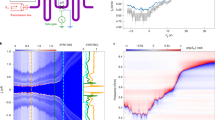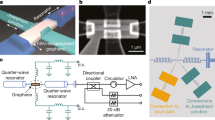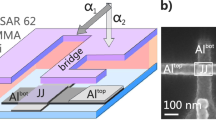Abstract
Josephson junctions (JJs) and their tunable properties, including their nonlinearities, play an important role in superconducting qubits and amplifiers. JJs together with the circuit quantum electrodynamics architecture form many key components of quantum information processing1. In quantum circuits, low-noise amplification of feeble microwave signals is essential, and Josephson parametric amplifiers (JPAs)2 are the widely used devices. The existing JPAs are based on Al–AlOx–Al tunnel junctions realized in a superconducting quantum interference device geometry, where magnetic flux is the knob for tuning the frequency. Recent experimental realizations of two-dimensional (2D) van der Waals JJs3,4,5 provide an opportunity to implement various circuit quantum electrodynamics devices6,7,8 with the added advantage of tuning the junction properties and the operating point using a gate potential. While other components of a possible 2D van der Waals circuit quantum electrodynamics architecture have been demonstrated, a quantum-noise-limited amplifier, an essential component, has not been realized, to the best of our knowledge. Here we implement a quantum-noise-limited JPA using a graphene JJ, that has a linear resonance gate tunability of 3.5 GHz. We report 24 dB amplification with 10 MHz bandwidth and −130 dBm saturation power, a performance on par with the best single-junction JPAs2,9. Importantly, our gate-tunable JPA works in the quantum-limited noise regime, which makes it an attractive option for highly sensitive signal processing. Our work has implications for novel bolometers; the low heat capacity of graphene together with JJ nonlinearity can result in an extremely sensitive microwave bolometer embedded inside a quantum-noise-limited amplifier. In general, this work will open up the exploration of scalable device architectures of 2D van der Waals materials by integrating a sensor with the quantum amplifier.
This is a preview of subscription content, access via your institution
Access options
Access Nature and 54 other Nature Portfolio journals
Get Nature+, our best-value online-access subscription
$29.99 / 30 days
cancel any time
Subscribe to this journal
Receive 12 print issues and online access
$259.00 per year
only $21.58 per issue
Buy this article
- Purchase on Springer Link
- Instant access to full article PDF
Prices may be subject to local taxes which are calculated during checkout




Similar content being viewed by others
Data availability
Source data are provided with this paper. The experimental data used in the figures of the main text are also available in Zenodo with the identifier https://doi.org/10.5281/zenodo.6966047. Additional data related to this study are available from the corresponding authors upon reasonable request.
Code availability
The code that supports the findings of this study is available from the corresponding authors upon reasonable request.
References
Devoret, M. H. & Schoelkopf, R. J. Superconducting circuits for quantum information: an outlook. Science 339, 1169–1174 (2013).
Bergeal, N. et al. Phase-preserving amplification near the quantum limit with a Josephson ring modulator. Nature 465, 64–68 (2010).
Heersche, H. B., Jarillo-Herrero, P., Oostinga, J. B., Vandersypen, L. M. K. & Morpurgo, A. F. Bipolar supercurrent in graphene. Nature 446, 56–59 (2007).
Calado, V. E. et al. Ballistic Josephson junctions in edge-contacted graphene. Nat. Nanotechnol. 10, 761–764 (2015).
Lee, G.-H., Kim, S., Jhi, S.-H. & Lee, H.-J. Ultimately short ballistic vertical graphene Josephson junctions. Nat. Commun. 6, 6181 (2015).
Wang, J. I.-J. et al. Coherent control of a hybrid superconducting circuit made with graphene-based van der Waals heterostructures. Nat. Nanotechnol. 14, 120–125 (2019).
Schmidt, F. E., Jenkins, M. D., Watanabe, K., Taniguchi, T. & Steele, G. A. A ballistic graphene superconducting microwave circuit. Nat. Commun. 9, 4069 (2018).
Kroll, J. G. et al. Magnetic field compatible circuit quantum electrodynamics with graphene Josephson junctions. Nat. Commun. 9, 4615 (2018).
Hatridge, M., Vijay, R., Slichter, D. H., Clarke, J. & Siddiqi, I. Dispersive magnetometry with a quantum limited SQUID parametric amplifier. Phys. Rev. B 83, 134501 (2011).
Vijay, R., Devoret, M. H. & Siddiqi, I. Invited review article: the Josephson bifurcation amplifier. Rev. Sci. Instrum. 80, 111101 (2009).
Aumentado, J. Superconducting parametric amplifiers: the state of the art in Josephson parametric amplifiers. IEEE Microw. Mag. 21, 45–59 (2020).
Roy, T. et al. Broadband parametric amplification with impedance engineering: beyond the gain-bandwidth product. Appl. Phys. Lett. 107, 262601 (2015).
Schmidt, F. E. et al. Current detection using a Josephson parametric upconverter. Phys. Rev. Appl. 14, 024069 (2020).
Ho Eom, B., Day, P. K., LeDuc, H. G. & Zmuidzinas, J. A wideband, low-noise superconducting amplifier with high dynamic range. Nat. Phys. 8, 623–627 (2012).
Macklin, C. et al. A near-quantum-limited Josephson traveling-wave parametric amplifier. Science 350, 307–310 (2015).
Massel, F. et al. Microwave amplification with nanomechanical resonators. Nature 480, 351–354 (2011).
Haller, R. et al. Phase-dependent microwave response of a graphene Josephson junction. Phys. Rev. Res. 4, 013198 (2022).
Larsen, T. et al. Semiconductor-nanowire-based superconducting qubit. Phys. Rev. Lett. 115, 127001 (2015).
de Lange, G. et al. Realization of microwave quantum circuits using hybrid superconducting-semiconducting nanowire Josephson elements. Phys. Rev. Lett. 115, 127002 (2015).
Larsen, T. et al. Parity-protected superconductor-semiconductor qubit. Phys. Rev. Lett. 125, 056801 (2020).
Dou, Z. et al. Microwave photoassisted dissipation and supercurrent of a phase-biased graphene-superconductor ring. Phys. Rev. Res. 3, L032009 (2021).
Stehlik, J. et al. Fast charge sensing of a cavity-coupled double quantum dot using a Josephson parametric amplifier. Phys. Rev. Appl. 4, 014018 (2015).
Joas, T., Waeber, A. M., Braunbeck, G. & Reinhard, F. Quantum sensing of weak radio-frequency signals by pulsed Mollow absorption spectroscopy. Nat. Commun. 8, 964 (2017).
Eddins, A. et al. High-efficiency measurement of an artificial atom embedded in a parametric amplifier. Phys. Rev. X 9, 011004 (2019).
Mallet, F. et al. Single-shot qubit readout in circuit quantum electrodynamics. Nat. Phys. 5, 791–795 (2009).
Braine, T. et al. Extended search for the invisible axion with the axion dark matter experiment. Phys. Rev. Lett. 124, 101303 (2020).
Walsh, E. D. et al. Graphene-based Josephson-junction single-photon detector. Phys. Rev. Appl. 8, 024022 (2017).
Lee, G.-H. et al. Graphene-based Josephson junction microwave bolometer. Nature 586, 42–46 (2020).
Kokkoniemi, R. et al. Bolometer operating at the threshold for circuit quantum electrodynamics. Nature 586, 47–51 (2020).
Walsh, E. D. et al. Josephson junction infrared single-photon detector. Science 372, 409–412 (2021).
Wang, L. et al. One-dimensional electrical contact to a two-dimensional material. Science 342, 614–617 (2013).
Titov, M. & Beenakker, C. W. J. Josephson effect in ballistic graphene. Phys. Rev. B 74, 041401 (2006).
Manucharyan, V. E. et al. Microwave bifurcation of a Josephson junction: embedding-circuit requirements. Phys. Rev. B 76, 014524 (2007).
Mutus, J. Y. et al. Strong environmental coupling in a Josephson parametric amplifier. Appl. Phys. Lett. 104, 263513 (2014).
Macklin, C. Quantum Feedback and Traveling-Wave Parametric Amplification in Superconducting Circuits. PhD thesis, Univ. of California, Berkeley (2015).
Butseraen, G. et al. A gate-tunable graphene Josephson parametric amplifier. Nat. Nanotechnol. https://doi.org/10.1038/s41565-022-01235-9 (2022).
Wang, J. I.-J. et al. Hexagonal boron nitride as a low-loss dielectric for superconducting quantum circuits and qubits. Nat. Mater. 21, 398–403 (2022).
Acknowledgements
We thank V. Singh, S. Gueron, Z. Dou, H. Bouchiat, P. C. Adak, S. Sinha, S. Ghosh and S. Hazra for helpful discussions and comments. We thank J. Saha, S. L. D. Varma, K. Maji, A. Bhattacharjee, G. Bothara and S. Das for experimental assistance. We acknowledge Nanomission grant SR/NM/NS-45/2016 and the DST SUPRA SPR/2019/001247 grant, along with the Department of Atomic Energy of Government of India (12-R&D-TFR-5.10-0100) for support. We also acknowledge support from the Department of Science and Technology, India, via the QuEST programme. Preparation of hBN single crystals was supported by the Elemental Strategy Initiative conducted by the Ministry of Education, Culture, Sports, Science and Technology, Japan (grant number JPMXP0112101001) and Japan Society for the Promotion of Science KAKENHI (grant numbers 19H05790 and JP20H00354).
Author information
Authors and Affiliations
Contributions
J.S. fabricated the devices. J.S. and K.V.S. took the measurements and analysed the data. S.G., A.H.M., I.D. and S.M. assisted in developing the device fabrication method and experimental set-up. K.W. and T.T. grew the hBN crystals. R.V. led the microwave measurements. J.S., K.V.S., R.V. and M.M.D. wrote the manuscript with input from all authors. M.M.D. supervised the project.
Corresponding authors
Ethics declarations
Competing interests
The authors declare no competing interests.
Peer review
Peer review information
Nature Nanotechnology thanks Kin Chung Fong and the other, anonymous, reviewer(s) for their contribution to the peer review of this work.
Additional information
Publisher’s note Springer Nature remains neutral with regard to jurisdictional claims in published maps and institutional affiliations.
Supplementary information
Supplementary Information
Supplementary Figs. 1–13 and Sections I–IX.
Source data
Source Data Fig. 2
Source data for Fig. 2.
Source Data Fig. 3
Source data for Fig. 3.
Source Data Fig. 4
Source data for Fig. 4.
Rights and permissions
Springer Nature or its licensor (e.g. a society or other partner) holds exclusive rights to this article under a publishing agreement with the author(s) or other rightsholder(s); author self-archiving of the accepted manuscript version of this article is solely governed by the terms of such publishing agreement and applicable law.
About this article
Cite this article
Sarkar, J., Salunkhe, K.V., Mandal, S. et al. Quantum-noise-limited microwave amplification using a graphene Josephson junction. Nat. Nanotechnol. 17, 1147–1152 (2022). https://doi.org/10.1038/s41565-022-01223-z
Received:
Accepted:
Published:
Issue Date:
DOI: https://doi.org/10.1038/s41565-022-01223-z
This article is cited by
-
Superconducting tunnel junctions with layered superconductors
Quantum Frontiers (2024)
-
The Roadmap of 2D Materials and Devices Toward Chips
Nano-Micro Letters (2024)
-
A gate-tunable graphene Josephson parametric amplifier
Nature Nanotechnology (2022)
-
Graphene amplifier reaches the quantum limit
Nature Nanotechnology (2022)



